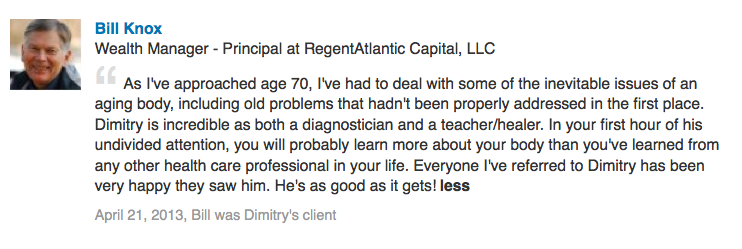
As I’ve approached age 70, I’ve had to deal with some of the inevitable issues of an aging body, including old problems that hadn’t been properly addressed in the first place. Dimitry is incredible as both a diagnostician and a teacher/healer. In your first hour of his undivided attention, you will probably learn more about your body than you’ve learned from any other health care professional in your life. Everyone I’ve referred to Dimitry has been very happy they saw him. He’s as good as it gets!
Now that you know what occurs in the shoulder region when you are in a slouch-sitting or slouch-standing position – take a look at how poor posture impacts the mobility of your neck or cervical spine. Most patients who suffer from cervical problems have this limitation because most patients w/ cervical problems sit for a living, weather they’re carpooling all day in the car or are executives who commute in the car and then sit all day only to get back into the car to commute home. Check out the radical change in mobility of your neck from just one simple movement adjustment – just you watch!
So now you know how to set up your shoulder blades for overhead motion. So how do you get the muscles that do all the work to get stronger so you keep what you have? Take a look!
So you have arms and you use them. But do you also use your shoulder blades? Do you move them correctly? Of course you don’t. Here’s how you do it and why!
Do we all stand the appropriate way? Do we slouch when we stand? How do we know? Most of the time we actually “hang” on our muscles and joints and don’t even engage them appropriately. This video shows you what happens when you break down and how to begin to address these issues. Check it out!
So here it is! A little “gem” on this Good Friday. Pay attention to this one . . . all you stiff and achy ones out there. It’s quick and easy . . . and may jsut save a life or three. A Good Friday indeed!
Here are two simple stretches that you can do to help out your tight hip flexors and the anterior hip capsule regions. The last two videos focused on screening for these deficits and this one goes through a simple kneeling hip flexor stretch and two versions of anterior hip capsule stretching as well.
Here’s another great little test you can do to find out what the mobility gain/loss is like for the anterior hip capsule. So many people complain of “a pinch” in the front of their hip regions and attribute it to tight hip-flexors. That may be the case, but some of the time there is a fair amount of involvement from the anterior hip capsule – a cartilaginous covering of the hip joint that extends from the perimeter of the femoral head (ball of the femur) and blends in with the lateral border of the acetabulum (hip socket.) Check out the video and see for yourself.
Everyone sits more then they stand and walk. Everyone sits more then they stretch. Everyone sits more then they run or exercise. Even the best of us are guilty. As a result, the hip flexor muscles are consistently tighter then they should be due to the shortening of the muscles in a seated position. In this video we show you how you can do a simple screen for tight anterior hip region mobility loss.
Here’s a quick tip on how you can help yourself overcome one of the most common shoulder complaints. Weather you have anterior or posterior shoulder pain – chances are you have a loss of mobility in the posterior capsule of your shoulder. Some deep tissue mobilization can easily restore that internal rotation at the shoulder joint so your shoulder blade/scapula does not have to “cash that extra check” and rotate as compensation.
